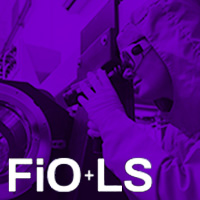Abstract
Broad bandwidth cavity enhanced spectroscopy provides a way to measure a wide absorption spectrum in parallel with very high sensitivity. Recent work, by use and other, in the field will be reviewed. Our recent work has focused on development of an ultrabroad bandwidth instrument, with in principle nearly two octave Radiation spanning ~500 nm – 1.8 micron is generated from a photonic crystal fiber pumped by a ~10 nsec pulse from a 30 KHz Nd:YAG laser. Up to about 30 microjoule per pulse can be focused into the ~3 micron core of the fiber. The output of the fiber contains about 50% of the input energy and is almost entirely converted into broadband light with a fairly flat spectrum. This radiation, after passing through a calcite polarizer is focused into a stable ring optical cavity formed by two prism retrorefletors. In each retroreflector, the light enters at or near Brewster’s angle (and thus has low loss for P polarization), undergoes two totally internal reflections beyond the critical angle by surfaces that form a right angle, and then leaves the prism, parallel to the entrance beam. On prism is tuned to precisely Brewster’s angle, while the second is detuned by on the order of 1°. Reflections from this surface act as input and output for the cavity. Loss per pass as low as 40 parts per million have been achieved in the near-IR, only a factor of 3 worse that the lowest loss dielectric mirrors we have been able to purchase. The output of the optical ring cavity is focused on the entrance slit of a 1 meter spectrograph, the output of which is focused on a camera. To date, we have used a Silicon CCD camera for the visible to about 900 nm. We expect to have results in the near IR (900-1.8 microns) using a InGaAs camera before the conference. In cavity enhanced spectroscopy, the absolute absorption spectrum can be determined if we know the empty cavity loss. We have used time correlated single photon counting to determine this despite the fact that we detect photons only at few kHz per resolution element. The later is diffraction limited at about 0.04 cm−1 with our instrument.
© 2007 APS
PDF ArticleMore Like This
Frank N. Keutsch, E.J. Moyer, D.S. Sayres, T.F. Hanisco, L. Lapson, N. Allen, J.H. Kroll, and J.G. Anderson
LWA1 Laser Science (LS) 2007
Manish Gupta, Andrew Fahrland, and J. Brian Leen
AM2A.3 Applied Industrial Optics: Spectroscopy, Imaging and Metrology (AIO) 2014
Jérôme Genest, Pierre Tremblay, Simon Roy, Philippe Saucier, Maxime Cadotte, Patrick Dubois, Simon Potvin, Geneviève Taurand, and Frédéric Talbot
FTuB2 Fourier Transform Spectroscopy (FTS) 2007

